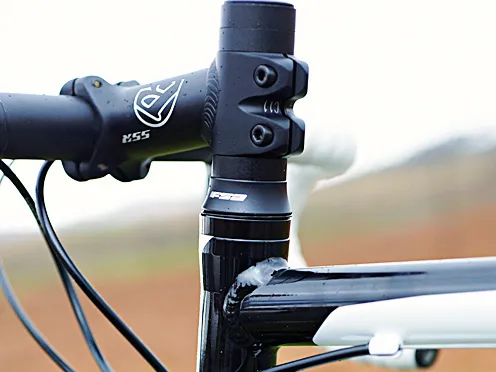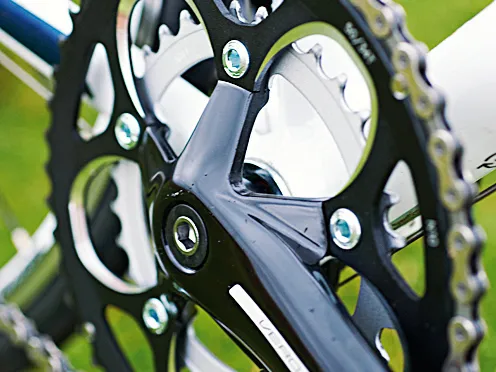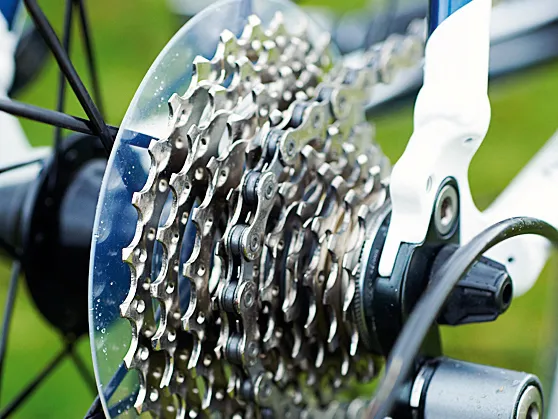Trek haven’t changed their entry-level road frame much for the past couple of years, but there are plenty of riders who want ‘sit up and beg’ comfort and relaxed handling in a road bike style, so there’s no reason they should. It wouldn’t be our first choice for more competitive work though.
Ride & handling: Comfortable enough for long rides and ideal for building confidence
There’s a fair amount of sideways flex in the Trek 1.5's tall head tube and narrow-stance fork if you bully rather than coax the steering. Starting with a downer on one small aspect of the handling is slightly unfair though, as the rest of the ride is unfailingly friendly and easy to live with.
Even Trek’s race bikes have a reputation for being more relaxed and surefooted than others and with a higher bar position and more centralised weight the 1.5 is even less threatening on descents or twisty lanes. High levels of vibration absorption in the slim, tall tubes reduce the chatter and ragged traction effect that can throw you off-line in rough conditions.
The tall cockpit height and shallow handlebar create a comfortable position when your hands are hooked into the more secure position of the drops, making the Trek a great confidence builder for those who don’t generally like to push their trust in tarmac traction. More accessible hand positions and the impressive amount of comfort for a mid-price alloy frame also make the 1.5 a welcoming place to be when you’re heading into work or putting in the long miles at the weekend.
The upright position means plenty of breathing space too, which, combined with the low complete bike weight and the extra-large rear cog on the cassette, means it cruises up steep hills surprisingly easily. Start applying pressure though and it’s less convincing. Flex from the crankset combines with a soft overall feel from the chassis – particularly when bracing bar against pedals – to take the edge off your effort before it reaches the road.
The upright position that saves your spine from too much strain but also prevents you from really putting your back into it or escaping from headwinds when you need too. However, keep your pedal revs high and your pedal pressure down and it’ll spin along quite happily. If you do use it for racing, you’ll find the fatigue reduction during the ride a bonus when you get to the run.

Chassis: Simple but relatively lightweight frameset builds a similarly light bike
Trek base the 1.5 around their H2 geometry, a higher fronted, more upright version of their H1 competition positioning. That’s the reason behind the very tall, slim head tube which is increased in effective height even further by the deep external cups of the FSA Intellaset headset on this build. Quite what extra intelligence it adds we weren’t able to confirm, but it certainly gives the bike a high brow.
There doesn’t seem to be much elaborate thinking in the tube shapes, with a round-to-straight top tube and only very slight shaping on the down tube. The D-section-to-round chainstays and oval-to-round seatstays finish at plain chunky dropouts, although the pearl and blue-black paint finish adds a dash of decorative class.
While Trek haven’t gone overboard on the external detailing or tube shaping, frame weight is still perfectly reasonable thanks to unseen butting that removes excess metal from the tube walls. Utility use is definitely still on the agenda though, and commuter use is certainly possible with rack and guard mounts at the rear and mudguard eyes on the slim crowned, carbon-legged fork.
Equipment: Square-taper crankset is a disappointment at this price
It seems that the £800 bike club is operating a strict “if you ain’t wearing Shimano Tiagra, you ain’t coming in” door policy this year. While the Trek will get past the bouncers outside, a close look at the FSA Vero compact chainset makes entry through the component ‘velvet rope’ less likely. While square-taper internal bottom brackets tend to last well, they’re also prone to more creak, flex and eventual removal trauma than external cups are.
There’s loads of mudguard/fat tyre clearance under the deep drop brakes though, and cartridge pads keep them reasonably sharp in feel despite the longer arms. While the ride position is far from aero, the Bontrager rimmed wheels get fashionable bladed spokes. They also use a new Clix skewer system and the front hub uses a larger than normal cam offset and a big locking collar, which means no more messing about with skewer wind-on/wind-off, which is great for cold-fingered puncture fixing or new riders. The ‘Plus’ puncture protection on the Bontrager R1 tyres should mean flats are less likely in the first place, though.
The Bontrager Approved gear is the lowest grade of named components, but it all does a decent job. The shallow compact bend makes the dropped section on the handlebar more useable but the long stem doesn’t have an entirely positive effect on handling – it has a tendency to lurch around at really slow speeds, so be careful if you’re chasing your tail on a quick turnaround.



